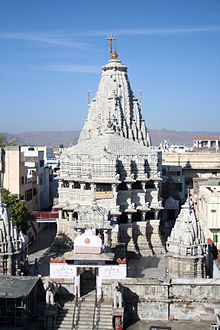Jagdish Temple, Udaipur

Multi tool use
| Jagdish Temple | |
|---|---|
 | |
 Location in Udaipur | |
| Geography | |
| Coordinates | 24°34′47.4024″N 73°41′1.899″E / 24.579834000°N 73.68386083°E / 24.579834000; 73.68386083Coordinates: 24°34′47.4024″N 73°41′1.899″E / 24.579834000°N 73.68386083°E / 24.579834000; 73.68386083 |
| Country | India |
| State | Rajasthan |
| District | Udaipur district |
| Locale | Udaipur |
Jagdish Temple is a large Hindu temple in the middle of Udaipur in Rajasthan, just outside the royal palace. It has been in continuous worship since 1651. A big tourist attraction, the temple was originally called the temple of Jagannath Rai but is now called Jagdish-ji. It is a major monument in Udaipur.[1]
Contents
1 Overview
2 Gallery
3 References
4 External links
Overview

Jagdish Temple in 1949
The Jagdish Temple is raised on a tall terrace and was completed in 1651. It attaches a double-storey Mandapa (hall) to a double-storey saandhara (with a covered ambulatory) sanctum. The mandapa has another storey tucked within its pyramidal samavarna (bellroof) while the hollow clustered spire over the sanctum contains two more, nonfunctional stories. To reach the main shrine, one must climb 32 marble steps, intercepted by a Brass image of Garuda in the end, being the mount (vahana) of God Vishnu. Shri Jagdish Temple is the most beautiful example of Hindu Iconography, consisting of three stories of hand carved stone, with a steeple nearly 79 feet high and is the largest temple of Udaipur.[2]
Lanes taking off from many of the sheharpanah (city wall) converge on the Jagdish Temple. It was built by Maharana Jagat Singh in 1651.[3] Jagdish Temple is a splendid example of either Māha Māru or the Māru-Gurjara architecture,[4] decorated by beautiful and ornate carvings. A short walk from the city palace will bring you to this temple. The temple sanctum has an idol of the deity Lord Jagannath, in local parlance of God Vishnu or God Krishna, carved out of a single black stone, resplendent with four arms, flowers and finery.[5] Four smaller shrines, dedicated to Lord Ganesha, Surya, Goddess Shakti and Lord Shiva form a circle around the main shrine, housing the idol of Lord Vishnu. It is said that an estimated RS 1.5 million (or 1,500,000) ($22023. 21) was spent to construct the building in 1651.
Gallery

Elephant carvings on Jagdish Mandir

Women during a prayer

festive decorations

Painting by John Gleich (1879 - 1927)
References
^ "Jagdish Temple". udaipur.org.uk. Udaipur India. Retrieved 5 September 2016..mw-parser-output cite.citation{font-style:inherit}.mw-parser-output q{quotes:"""""""'""'"}.mw-parser-output code.cs1-code{color:inherit;background:inherit;border:inherit;padding:inherit}.mw-parser-output .cs1-lock-free a{background:url("//upload.wikimedia.org/wikipedia/commons/thumb/6/65/Lock-green.svg/9px-Lock-green.svg.png")no-repeat;background-position:right .1em center}.mw-parser-output .cs1-lock-limited a,.mw-parser-output .cs1-lock-registration a{background:url("//upload.wikimedia.org/wikipedia/commons/thumb/d/d6/Lock-gray-alt-2.svg/9px-Lock-gray-alt-2.svg.png")no-repeat;background-position:right .1em center}.mw-parser-output .cs1-lock-subscription a{background:url("//upload.wikimedia.org/wikipedia/commons/thumb/a/aa/Lock-red-alt-2.svg/9px-Lock-red-alt-2.svg.png")no-repeat;background-position:right .1em center}.mw-parser-output .cs1-subscription,.mw-parser-output .cs1-registration{color:#555}.mw-parser-output .cs1-subscription span,.mw-parser-output .cs1-registration span{border-bottom:1px dotted;cursor:help}.mw-parser-output .cs1-hidden-error{display:none;font-size:100%}.mw-parser-output .cs1-visible-error{font-size:100%}.mw-parser-output .cs1-subscription,.mw-parser-output .cs1-registration,.mw-parser-output .cs1-format{font-size:95%}.mw-parser-output .cs1-kern-left,.mw-parser-output .cs1-kern-wl-left{padding-left:0.2em}.mw-parser-output .cs1-kern-right,.mw-parser-output .cs1-kern-wl-right{padding-right:0.2em}
^ Shri Jagdish Temple, the Largest Temple in Udaipur, Rajasthan
^ "My Kind of Place: Udaipur, India". thenational.ae. thenational. Retrieved 5 September 2016.
^ Bose, Melia Belli (1997). Royal Umbrellas of Stone: Memory, Politics, and Public Identity in Rajput Funerary. BRILL. ISBN 9004300562.
^ "Udaipur - The City of Lakes". trayaan.com. 2015-12-02. Retrieved 2016-10-05.
External links
| Wikimedia Commons has media related to Jagdish Temple. |
This article about an Indian Hindu place of worship is a stub. You can help Wikipedia by expanding it. |
This article related to Udaipur is a stub. You can help Wikipedia by expanding it. |
3uIfk,iml0,mdvuQgYYRB1YgSFPH0xCaRMijM9,pSTZz4 pdhiho iBibY



